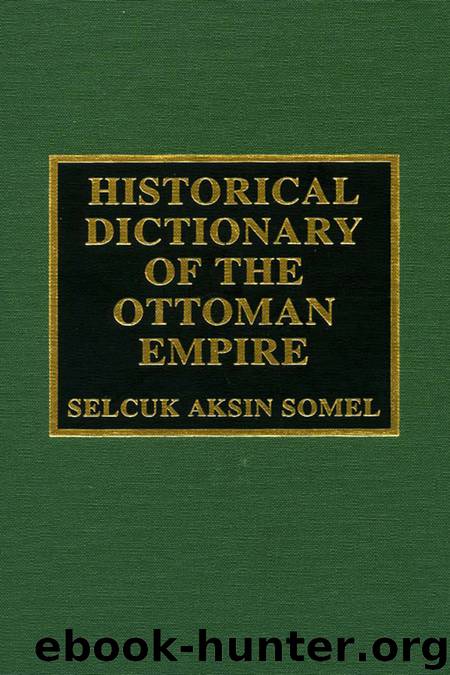Historical Dictionary of the Ottoman Empire by Selcuk Aksin Somel

Author:Selcuk Aksin Somel
Language: eng
Format: epub
ISBN: 9780810866065
Publisher: Scarecrow Press
– M –
MACEDONIA. Geographical area in the Balkans and embracing the Former Yugoslav Republic of Macedonia, present northern Greece, western Bulgaria, and southeastern Albania. The Ottoman presence in Macedonia became fully established after the first Battle of Kosovo (1389), even though certain parts, such as Thessaloniki (Selânik), finally came under Ottoman control only in 1430. During the classical period, Macedonia was at the center of the Rumeli beglerbegilik, with its capital at Bitola (Monastir). The demographic composition of Macedonia was changed by colonization by Turco-mans along the Vardar Valley and around the region of Serfice (Servia). A further part of the local population was gradually Islamized. Cities and towns were centers of Ottoman Islamic culture, whereas Christians were largely confined to rural areas. The timar system was fully applied.
The Ottoman political and economic decline from the end of the 16th century onward affected Macedonia. The exhausting war between 1683 and 1699 and the presence of a Habsburg army in Macedonia displayed the vulnerability of the Ottomans to the local Christian population. The Hellenized Christian townspeople of Macedonia showed the first signs of separatism under the influence of European Enlightenment ideas. The Slav peasantry of Macedonia acquired something of a national consciousness as a result of Bulgaro-Macedonian educational activities in the 19th century. The separation of the Bulgarian Orthodox Church (exarchate) from the Greek Orthodox Patriarchate (1870) meant at the same time the official recognition of a separate Bulgarian community (millet).
The Slavs of Macedonia became the subject of conflict between the two churches, Bulgarian and Greek, each, after 1878, with a political backer—respectively the Bulgarian principality and the Greek kingdom. Both sought to expand their spheres of cultural influence in Ottoman Macedonia. Though the Congress of Berlin (1878) preserved Ottoman administration in Macedonia (the vilâyets of Mona-stir, Thessaloniki, and Kosovo), the intensifying guerilla activities of Bulgaro-Macedonians, Greeks, and Serbs created civil war conditions in the region. The rebellion of 1903, instigated by the Bulgaro-Macedonian Internal Macedonian Revolutionary Organization, resulted in the diplomatic intervention of the great powers.
According to a new reform program drawn up by Austria and Russia and supported by other powers, the security and the finances of Macedonia were to be reorganized under the supervision of the great powers. This program, designed for the benefit of the local Christian population, created uneasiness among the Turkish and Albanian Muslims about their future political status. While Albanians organized a nationalist guerilla group (1905), local Turkish officials and military officers joined the secret Committee of Union and Progress. For these officials the sultan’s diplomatic concessions to the great powers constituted treason. The revolt of the Ottoman Second Army Corps in Macedonia and the guerilla activities of Enver and Niyazi Beys against the Hamidian regime finally forced the sultan to restore the constitutional regime (1908). The Ottoman presence in Macedonia ended with the Balkan Wars (1912–13). See also NATIONALISM; ZİMMÎ.
MAHMUD I (1696–1754). Ottoman sultan. Son of Mustafa II and successor of his uncle Ahmed III.
Mahmud I acceded to the throne following the Patrona Halil Revolt (1730).
Download
This site does not store any files on its server. We only index and link to content provided by other sites. Please contact the content providers to delete copyright contents if any and email us, we'll remove relevant links or contents immediately.
A Dictionary of Sociology by Unknown(3044)
The Art of Dramatic Writing: Its Basis in the Creative Interpretation of Human Motives by Egri Lajos(3039)
The Dictionary of Body Language by Joe Navarro(2970)
0041152001443424520 .pdf by Unknown(2819)
How The Mind Works by Steven Pinker(2782)
Day by Elie Wiesel(2749)
Merriam-Webster's Collegiate Thesaurus, Second Edition by Merriam-Webster Inc(2731)
The Meaning of the Library by unknow(2537)
The Official Guide to the TOEFL Test by ETS(2301)
A History of Warfare by John Keegan(2214)
The Emotion Thesaurus: A Writer's Guide to Character Expression by Puglisi Becca & Ackerman Angela(2127)
Emotion Amplifiers by Angela Ackerman & Becca Puglisi(2016)
MASTER LISTS FOR WRITERS: Thesauruses, Plots, Character Traits, Names, and More by Bryn Donovan(1923)
Merriam-Webster's Pocket Dictionary by Merriam-Webster(1910)
The Cambridge Guide to English Usage by PAM PETERS(1890)
Star Wars The Rise of Skywalker The Visual Dictionary by Pablo Hidalgo(1865)
More Than Words (Sweet Lady Kisses) by Helen West(1840)
Lucky Jim by Kingsley Amis(1730)
American Accent Training by Ann Cook(1643)
